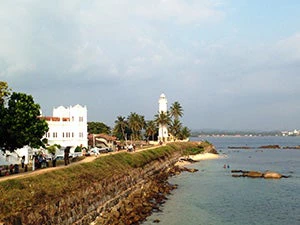
Unexpectedly, during the mission, I found such a mobile application being developed by University of Colombo School of Computing (UCSC)’s modeling and simulation group through a research and commercialization grant awarded by the HETC project. I became really excited about their project as my little wish in Galle just became true in less than a week.

UCSC has been conducting research on multi domain (including 2D and 3D) simulation especially on vessel management and handling and winning various national and international awards. Applying this existing technology to a tourism industry, a mobile application project called “Virtual Eye” has started. This application captures 3D images of Galle (selected as the first pilot site) and allows users to look at the simulation images with archeological and historical information of relics and sites from various colonial ages. The application will also include some touristic information, including restaurants and shops around the area. The project has just started and the team aims to finish developing this application within a year.
Innovation often takes place through interaction among people from different background and disciplines. The “Virtual Eye” project is not an exception. A team from UCSC shared a story on how the project has started. In order to expose their research and create a collaboration opportunity with other sectors, UCSC held an exhibition and invited various firms and government sectors. Ministry of Tourism and the department of archeology of University of Colombo were among one of them started talking to the UCSC team to brainstorm ideas on possible applications of the simulation technology to a tourism sector. Further conversations led to a “Virtual Eye” mobile application project. This project is partially funded by the Ministry of Tourism and the UCSC team will have access to archeological information from museums to develop a simulation. One of the team members said that she did not expect that their simulation technology could have been used for tourism and she look forward to exploring such innovative collaboration opportunities for the future.
Like other parts of the world, realizing commercialization of research through universities-industry-government partnership is easier said than done as all these parties speak different languages and have different incentives. In the case of “Virtual Eye” project, government-university relation was created through finding a shared goal aligning with each party’s interest. Yet, commercialization of the product is a next challenge. UCSC team mentioned that the majority of the faculties and students are interested in research and do not have much idea on business development and formation of the company. Regulations around intellectual property (IP) rights and ownership rights for the university’s research commercialization activities are also at the nascent stage.
Moving forward, the World Bank team will support universities to commercialize their research more effectively through connecting them with business development experts and facilitating policy dialogue on Intellectual Property Policy for universities.
HETC project’s QIG developed a foundation for the universities to foster research and commercialization activities. Although this is just a beginning of Sri Lanka’s innovation eco-system development, I hope to see a “Virtual Eye” application on my phone when I visit Sri Lanka next time and see other innovations coming out from the universities.
Photos courtesy of Saori Imaizumi and Dilinika Peiris of the World Bank


Join the Conversation